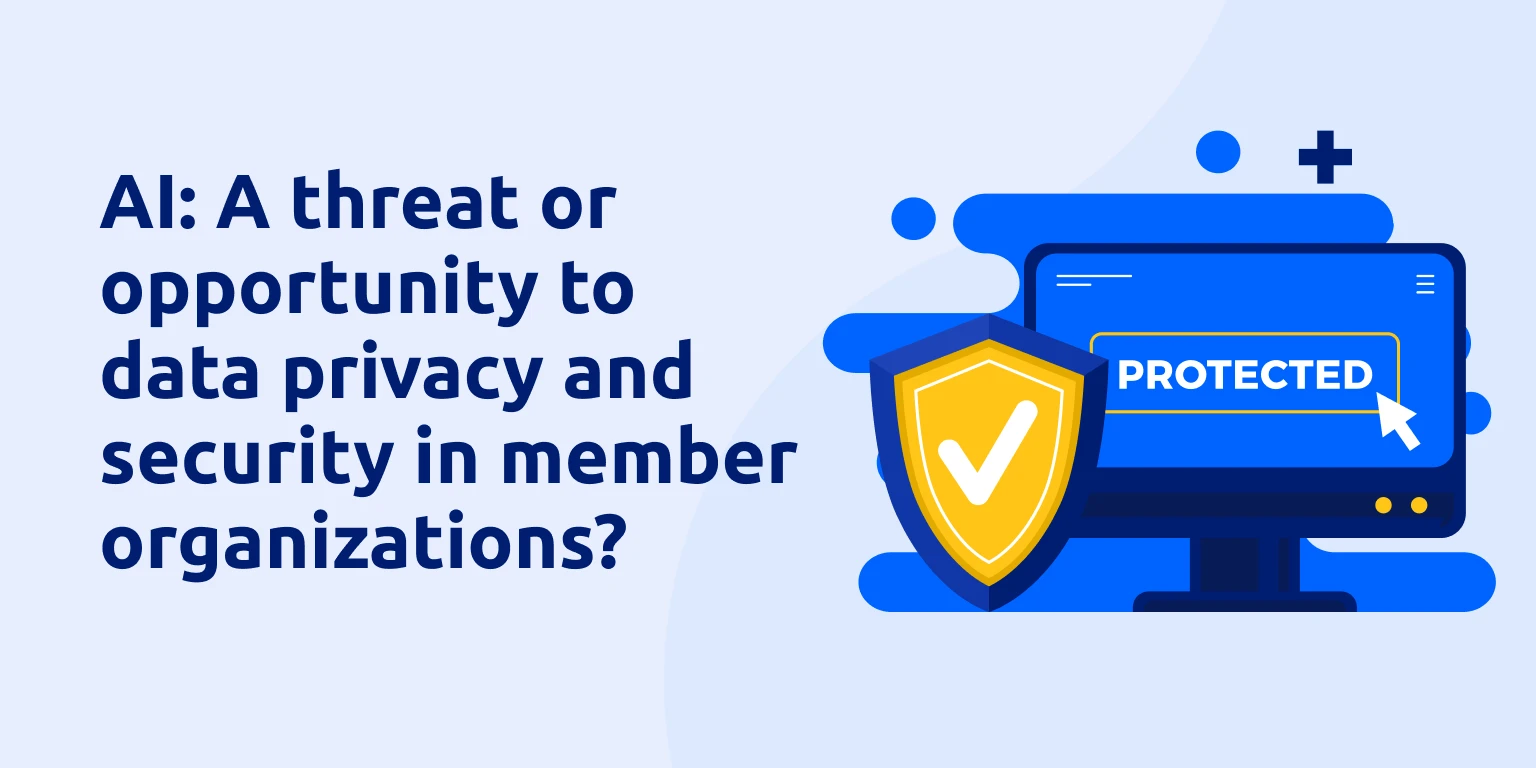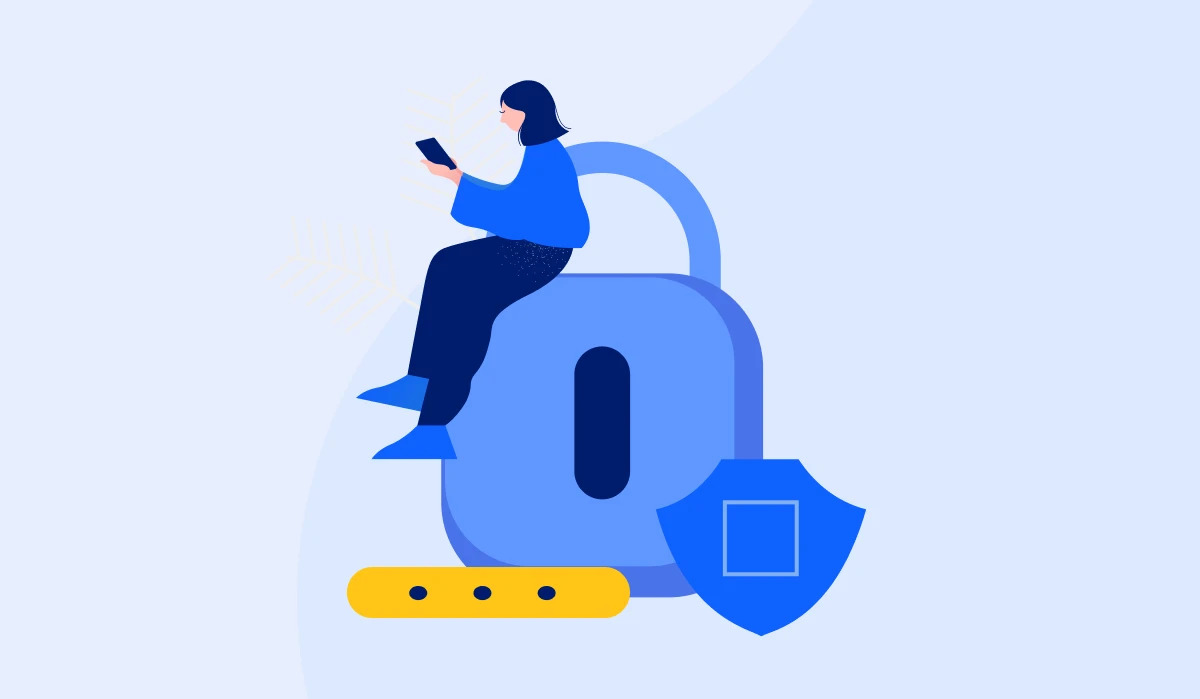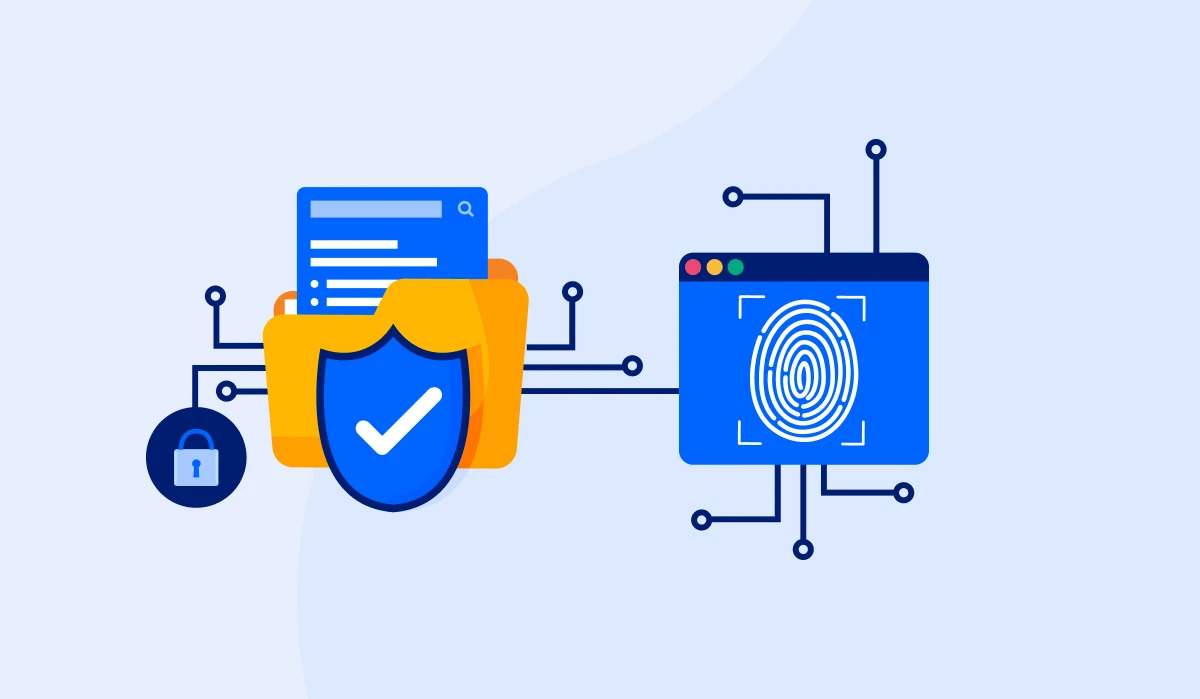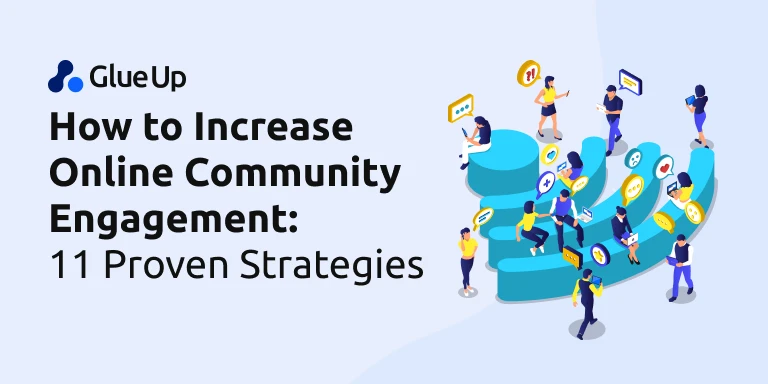
The internet has connected people and allowed the free flow of information like never before. This unprecedented level of networking, however, has also given rise to new challenges. Issues surrounding data privacy, content security, and the safeguarding of online communities have become increasingly prominent with the advent of AI.
On one hand, it holds the potential to exacerbate these challenges, posing threats to data privacy and security, and even to the very existence of certain organizations. On the other hand, AI also presents promising solutions to these issues, offering innovative ways to manage and protect data, enhance content security, and foster safer online communities.
For membership organizations, this presents a critical question: Is AI an existential threat that could undermine their operations and member data privacy, or is it an opportunity to enhance their services, improve security, and provide greater value to their members?
In the following sections, we will delve deeper into this question, exploring the potential risks and rewards of AI for membership organizations, and discussing how you can navigate the complex landscape of AI in the digital age.
Quick Reads
- The Hidden Risks of AI for Member-Based Organizations
- Shielding Your Data: How to Counter AI and Scraping Threats?
- Enhancing Security with Glue Up's Private Online Community: A Defense Against AI and Scraping Threats
The Hidden Risks of AI for Member-Based Organizations
While AI promises numerous benefits for member-based organizations, such as improved personalization and operational efficiency, there are hidden risks that cannot be ignored.
Here is a list of the risks that AI and web crawlers pose to your organization and member data.
Mass Scraping of Content Without Consent
Member-based organizations face unique challenges in the age of web scraping and AI models like GPTbot and CCBot.
Your organization isn't just protecting its own content; it's safeguarding the data of all your members. This includes sensitive information, proprietary programs, and events that may be key to your organization's mission and financial health.
Web scrapers can ignore voluntary protocols like robots.txt, posing a security risk to your organizational and member data. This calls for the implementation of stronger security measures such as robust authentication, and encryption to ensure that your content and content are not part of a dataset for AI models without your consent.
Inadequate Tools to Prevent Scraping
Member-based organizations face a growing concern when it comes to preventing the unauthorized scraping of their content.
The robots.txt protocol that websites use to block scrapers is voluntary and easy to bypass, raising significant challenges for these organizations.
One of the core issues is that robots.txt lacks any real enforcement mechanism; it carries no legal authority. This means that even when organizations explicitly express their intent to prohibit scraping through this protocol, it doesn't necessarily deter determined scrapers.
Crawlers can simply ignore the robots.txt directives and continue to scrape sites anyway, making it difficult for member-based organizations to protect their valuable content.
Additionally, robots.txt relies on disclosing crawler names, which means that scrapers can easily change names or obfuscate their identities to evade blocking attempts. This further undermines the effectiveness of this tool for organizations attempting to safeguard their data and proprietary content from AI-driven scraping activities.
Copyright Issues and Legal Frameworks

The mass scraping of content challenges existing copyright laws, creating uncertainty around the value and ownership of proprietary content.
The use of AI to scrape and repurpose content complicates traditional understandings of copyright enforcement. This not only threatens the financial well-being of the organization but also undermines the integrity of copyright systems in the digital age.
Emerging AI technologies may further blur the lines by creating derivatives or adaptations of copyrighted content, thereby complicating the issue of what constitutes a violation.
These derivative works could end up being distributed widely, making it challenging to trace back to the original infringement and hold the responsible parties accountable.
Potential Loss of Open-Sharing Culture
The threat of scraping and misuse of data might discourage member-based organizations from embracing a culture of open sharing. This could lead to decreased community engagement, fewer collaborative projects, and ultimately a less vibrant organizational culture.
When members fear that their contributions could be compromised, the intrinsic motivation to share and collaborate diminishes.
Moreover, the risks extend to shared databases and forums where members might upload valuable proprietary data or research for collaborative purposes. AI can target these resources, scraping and utilizing them in ways that undermine the very essence of a sharing culture, further eroding trust within the community.
Lack of Consensus on Data Usage Norms

Member-based organizations should play an active role in the conversations between tech companies, researchers, and content creators to help develop fair standards.
The lack of a unified stance on data usage norms exacerbates the challenges faced by these organizations. When each stakeholder has a different understanding of what is acceptable, it becomes almost impossible to form a cohesive, protective strategy.
Moreover, the rapid pace at which AI technologies evolve outstrips the speed of legislative or normative responses. This leaves member-based organizations in a vulnerable state, continuously playing catch-up and dealing with the consequences of data misuse rather than proactively addressing them.
Threats to Openness and Creativity
The internet has thrived because of an open exchange of ideas and information. However, AI challenges this ethos, particularly in the context of member-based organizations.
Striking the right balance between openness and asset protection has become incredibly difficult. There is a risk of drifting towards a more closed-off, restrictive approach in an attempt to protect assets, which goes against the foundational principles of many such organizations.
At the same time, AI can potentially exploit open channels to access, analyze, and manipulate content. This creates an unsettling paradox where openness, which should be a strength, becomes a vulnerability.
The challenge of maintaining openness while protecting assets thus becomes not just a technical issue but a fundamental concern that may require rethinking the very foundations of how member-based organizations operate.
Shielding Your Data: How to Counter AI and Scraping Threats?
As AI and web scraping become more prevalent, safeguarding your organization's data has never been more essential. To fortify your defenses against these threats, consider implementing a combination of strategies:
Use of Cookies and Javascript Verification
One of the first lines of defense against web scrapers is the use of cookies or Javascript to verify that the visitor is a web browser. Most web scrapers do not process Javascript, making this an effective deterrent.
Data Obfuscation
Web scrapers crawl data in text format. Therefore, publishing data in image or flash format can serve as a deterrent. This technique, known as data obfuscation, makes it harder for scrapers to extract useful information.
Detecting and Blocking Malicious Sources
Organizations can locate and block access to known site scrapers. This includes competitors and potential attackers. Monitoring access to your website and identifying unusual patterns can help detect potential scraping activities.
Implementing CAPTCHA Mechanisms
CAPTCHA-based mechanisms, like Arkose MatchKey, can verify the authenticity of the user, making it harder for bots to access the data. These mechanisms can be particularly effective when combined with other security measures.
Frequent Update and Modification
Frequently changing your HTML codes and patterns can make it harder for HTML parsers and scrapers to extract data. This is especially important for sites with a collection of similar content that may naturally form HTML patterns.
Making Content Available for Members Only

If bots scraping your data becomes a significant issue, consider making your content available for members only. This can be done selectively if there is value in exposing some of it, such as for SEO purposes.
Monitoring and Mitigating Web Scraper Bot Activities
Monitoring and mitigating activities from malicious web scraper bots is crucial. This can be done manually or through automated tools that detect scraping attempts in real time and send alerts when suspicious activities are detected.
Legal and Regulatory Compliance
Ensure compliance with regulations such as the EU General Data Protection Regulation (GDPR) and the California Consumer Privacy Act (CCPA). These regulations provide guidance on how to access and use data from the internet properly.
Leveraging Private Online Communities
Private online communities can serve as a powerful tool for member-based organizations to protect their data. These communities provide a secure platform where members can interact, share ideas, and access exclusive content.
The private nature of these communities means that access is restricted to approved members only, significantly reducing the risk of data scraping. Furthermore, these platforms often come with built-in security measures, including data encryption and robust access controls, which further enhance data protection.
Protecting Data Privacy and Security with Glue Up's Private Online Community: A Defense Against AI and Scraping Threats
Glue Up's community management software is a robust private social media platform, meticulously crafted to safeguard your members' data.
This platform is exclusively designed for member-based organizations, providing a robust solution to the challenges of data security breaches and content theft by web crawlers. Glue Up's unwavering commitment to privacy ensures that member data remains confidential and secure, thereby fostering a sense of trust within the community.
This privacy-centric approach forms the bedrock of Glue Up's security strategy, guaranteeing the protection of member data at all times.
Additionally, Glue Up's private online community employs a comprehensive, multi-tiered strategy to thwart attacks from AI and scrapers. The first line of defense is the robust firewalls that regulate access between networks and obstruct unauthorized traffic. These firewalls are persistently updated and monitored to ensure they can effectively neutralize evolving threats.
Beyond firewalls, Glue Up fortifies your security through additional measures such as:
Secure Servers
All servers that run Glue Up software in production are recent, continuously patched Linux systems following the latest industry standards.
Depending on the domain your account is on, your data is stored following specific regulations in a given country. This ensures that your data is not only secure but also compliant with local regulations.
Advanced Storage & Encryption

Glue Up employs advanced storage and encryption techniques. Document data such as metadata, activity, original files, and customer data are stored in different locations while also compiling and generating documents when requested.
All data in each location is encrypted at rest with AES-256 and sophisticated encryption key management. This advanced storage and encryption system ensures that your data is secure, no matter where it is stored.
Secure Customer Payment Information
Glue Up integrates with many payment gateways, all of which are compliant with PCI DSS. The platform does not process, store, or transmit any payment card data, ensuring that your financial information remains secure and confidential.
This commitment to financial security is a key aspect of Glue Up's comprehensive approach to data security.
System Monitoring and Alerting
Glue Up's system monitoring and alerting capabilities are a key aspect of its security strategy. The production application and underlying infrastructure components are monitored 24/7/365 days a year, by dedicated monitoring systems.
Critical alerts generated by these systems are sent to 24/7/365 on-call DevOps team members and escalated appropriately to operations management. This constant monitoring ensures that any potential threats or issues are identified and addressed promptly, ensuring the ongoing security and reliability of the platform.
Reliable Service Levels and Backups
Glue Up infrastructure utilizes many layered techniques for increasingly reliable uptime (<99.9%). Including the use of auto-scaling, load balancing, task queues, and rolling deployments.
Full daily automated backups of databases are performed, and all backups are encrypted. This ensures that your data is not only secure but also readily available when you need it.
Regular Vulnerability Testing
Web application security is a key focus for Glue Up. The development team regularly evaluates web application security in sync with the application release cycle.
This vulnerability testing includes the use of commonly known web application security toolkits and scanners to identify application vulnerabilities before they are released into production.
Regular vulnerability testing ensures that any potential security issues are identified and addressed before they can pose a threat, ensuring the ongoing security and reliability of the platform.
In conclusion, the rise of Artificial Intelligence has ushered in both opportunities and challenges for membership organizations. While AI holds the promise of improved services and operational efficiency, it also poses significant risks such as unauthorized content scraping, copyright concerns, and threats to open-sharing cultures.
To combat these challenges, you must deploy a multifaceted defense strategy, including technical measures like cookies, data obfuscation, and CAPTCHA mechanisms, alongside legal compliance and vigilant monitoring of web scraper activities.
Furthermore, embrace robust community management software like Glue Up. Their commitment to privacy, secure servers, advanced encryption, secure payment handling, vigilant monitoring, and regular vulnerability testing provides a comprehensive shield against AI and web scraping threats.
By adopting these measures and leveraging Glue Up's capabilities, you can not only protect your data and member data privacy but also thrive in the digital age while preserving their commitment to open sharing and community engagement.



